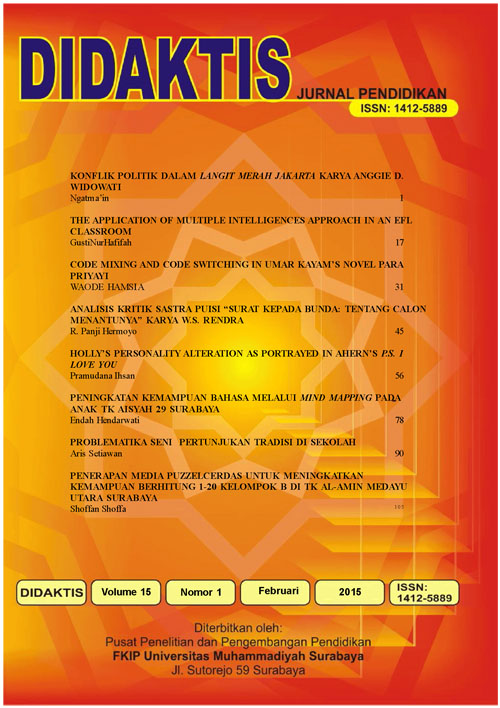The Application of multiple Intelligences Approach in an EFL Classroom
Abstrak
This study attempts to observe the Multiple Intelligences teaching Strategy being used by an English Teacher in an EFL Classroom. To what extent the Teacher applied the eight Multiple Intelligences Teaching Strategies in the English Teaching Learning Process. The MI Teaching Strategies are;Linguistic Strategy, Logical/ Mathematical Strategy, Visual/Spatial Strategy, Bodily/Kinesthetic Strategy, Musical Strategy, Interpersonal Strategy, Intra-personal Strategy, and Naturalist Strategy.
Since this study was descriptive qualitative study, the researcher described and evaluated the existing phenomena during the observation and also the result of the interview. In this case, the subject of the study wasthe English Teacher in SMP Muhamadiyah 9, which published its school as a Multiple Intelligences Based School. The observation was done in nine meetings of English Subject, involving 2 different classes. Furthermore, the instrument used was the researcher herself as the observer of the study and interviewer.
The result showed that the MI Teaching Strategy was not applied optimally in the classroom. Teacher applied some seven from the Eight Intelligences Strategies being observed, such as Linguistic Strategy, Logical/ Mathematical Strategy, Visual/Spatial Strategy, Bodily/Kinesthetic Strategy, Interpersonal Strategy, Intrapersonal Strategy, and Naturalist Strategy. The Musical Intelligence Strategy was not found on the observation since teacher’s voice was the only source of music and there wasn’t any use of sounds music or rhythm during the teaching. And the Linguistic Intelligence Strategy was the most dominated strategy as language was the main subject of the lesson. It can be concluded that MI Strategies depend very much on the teacher ability in creating creative and innovative ideas in developing teaching techniques that suitable to the variety of intelligence that the students have.
Key Words: Multiple Intelligences; Linguistic, Linguistic, Logical/ Mathematical, Visual/Spatial, Bodily/Kinesthetic, Musical, Interpersonal, Intrapersonal, and Naturalist Intelligences, Teaching Strategies.
Artikel teks lengkap
Referensi
Armstrong, T. 1994. Multiple Intelligences in the Classroom. Alexandria, Va.: Association for Supervision and Curriculum Development.
Bas, Gokhan. 2008. Integrating Multiple Intelligences in ESL/EFL Classrooms. The Internet TESL Journal. Vol. XIV (5). (May).
Bas, Gokhan. 2008. Implementation of Multiple Intelligences Supported Project-Based Learning in EFL/ESL Classrooms. Karen’s Linguistics Issues.
Bell, Roger T. 1987. An Introduction to Applied Linguistic Approaches and Methods in Language Teaching. London: B.T. Batsford.
Bogdan, R.C. &Biklen, S. R. 1982.Qualitative Research for Education.An Introduction to Theory and Methods.Allyn and Bacon, Inc.
Campbell, L. 1997. How teachers interpret MI theory. Educational Leadership. Vol. 55 (1): 15-19
Christison, M.A. (1996). Teaching and Learning Languages Through Multiple Intelligences. TESOL Journal, Vol. 6 (1), 10-14.
Christison, M.A. (1999a). A guidebook for applying multiple intelligences theory in the ESL/EFL classroom. Burlingame, CA: Alta Book Center.
Christison, M.A. (1999b). Multiple intelligences.ESL Magazine. Vol. 2 (5), 10-13.
Christison, M. 1997. An Introduction to Multiple intelligences theory and second Language Learning. In J. Reid (ed.), Understanding Learning Styles in the second Language Classroom. Englewood Cliffs, N.J.: Prentice Hall/Regents. 1-14.
Christison, M. 1998. Applying Multiple Intelligences Theory in pre-service and in-service TEFL education programs. English Language Teaching Forum. 36(2) (April-June): 2-13.
Christison, M. 1999. Multiple Intelligences: Teaching the whole student. ESL Magazine 2(5): 10-13
Christison, M. 2001. Applying Multiple Intelligences Theory in the Second and Foreign Language Classroom. Burlingame, Calif: Alta Book Center Publishers.
Christison, M and Kennedy, D. 2004.Multiple Intelligences: Theory and Practice in Adult ESL. ERIC Digest.
Clark, Leonard H. and Starr, Irving S. 1981.Secondary and Middle School Teaching Methods. New York: Macmillan.
Creswell, John. W. 2002. Educational Research: Planning, Conducting and Evaluating Quantitative and Qualitative Research. Upper Saddle River-New Jersey: Pearson Education, Inc.
Currie, Karen L. 2003.Multiple Intelligence Theory and the ESL Classroom—Preliminary Considerations.The Internet TESL Journal.Vol. IX (4) (April)
Fleetham, M. 2006. Multiple Intelligences in Practice-Enhancing self-esteem and learning in the classroom.Network Continuum Education.
Gardner, H. (1999a). Intelligence reframed: Multiple intelligences for the 21st century. New York: Basic Books.
Gardner, H. (1999b, February). Who owns intelligence? Atlantic Monthly, 67-76.
Gardner, H. (1998). Are there additional intelligences? The case for naturalist, spiritual, and existential intelligences.In J. Kane (Ed.), Education, information, and transformation (pp. 111-131). Upper Saddle River, NJ: Merrill-Prentice Hall.
Gardner, H. (1995). Reflections on multiple intelligences. Phi Delta Kappan, 77(3), 200-208.
Gardner, H. 1985. Frames of Mind: The theory of Multiple Intelligences. New York: Basic Books.
Gardner, H. 1993. Multiple Intelligences: The Theory and Practice. New York: Basic Books
Haley, M. H. 2004. Learner-Centered Instruction and the Theory of Multiple Intelligences with Second Language Learners. Teachers College Record. Columbia University Vol. 106 (1) (January): 163-180.
Mahdavy, B. 2008. The Role of Multiple Intelligences (MI) in Listening Proficiency : A Comparison of TOEFL and IELTS Listening Tests from an MI Perspective. The Asian EFL Journal.Vol. 10 (3).September.
Nicholson-Nelson, K. 1998.Developing Students’s Multiple Intelligences. New york: Scholastic.
Richards, J. C and Rodger, T. S. 2001.Approaches and Methods in Second Language Teaching.Cambridge University Press.
Richards, J. C and Renandya, Willy. A. 2002. Methodology in Language Teaching.An Anthology of Current Practice. Cambridge University Press.
Seliger, H. W. &Shohamy, E. 1989.Second Language Research Method.Oxford University Press.
Penulis
Hak cipta berada di tangan penulis
Artikel yang terbit dapat digunakan di bawah lisensi Creative Commons Attribution-NonCommercial 4.0 International License.


